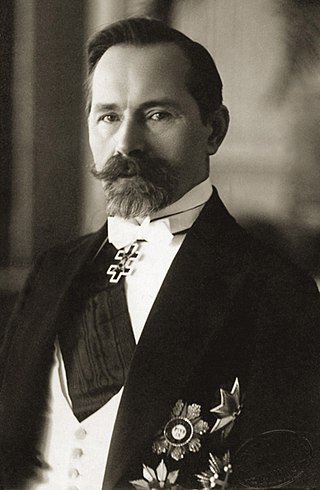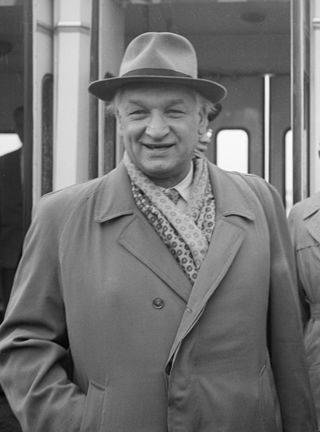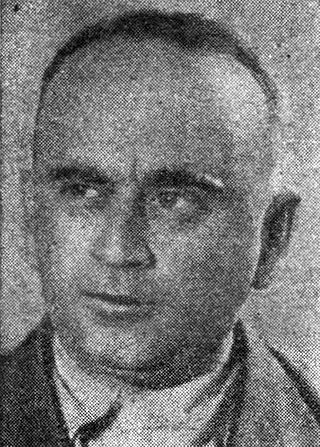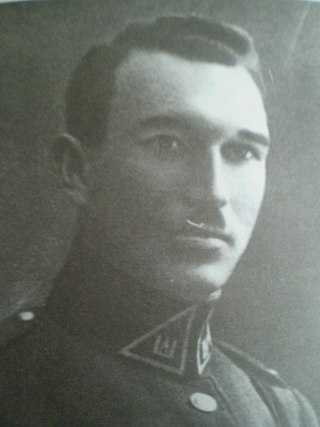
Antanas Smetona was a Lithuanian intellectual, journalist and politician. He served as the first president of Lithuania from 1919 to 1920 and later as the authoritarian head of state from 1926 until the Soviet occupation of Lithuania in 1940. Referred to as the "Leader of the Nation" during his presidency, Smetona is recognised as one of the most important Lithuanian political figures between World War I and World War II, and a prominent ideologist of Lithuanian nationalism and the movement for national revival.

Augustinas Voldemaras was a Lithuanian nationalist political figure. He briefly served as the country's first prime minister in 1918 and continued serving as the minister of foreign affairs until 1920, representing the fledgling Lithuanian state at the Versailles Peace Conference and the League of Nations. After some time in academia, Voldemaras returned to politics in 1926, when he was elected to the Third Seimas.

The Lithuanian Soviet Socialist Republic, also known as Soviet Lithuania or simply Lithuania, was de facto one of the constituent republics of the Soviet Union between 1940–1941 and 1944–1990. After 1946, its territory and borders mirrored those of today's Republic of Lithuania, with the exception of minor adjustments to its border with Belarus.

Antanas Merkys was the last Prime Minister of independent Lithuania, serving from November 1939 to June 1940. When the Soviet Union presented an ultimatum to Lithuania demanding that it accept a Soviet garrison, President Antanas Smetona fled the country leaving Merkys as acting president. Merkys ostensibly cooperated with the Soviets, and illegally took over the presidency in his own right. After three days, Merkys handed power to Justas Paleckis, who formed the People's Government of Lithuania. When Merkys attempted to flee the country, he was captured and deported to the interior of Russia, where he died in 1955.

Justas Paleckis was a Lithuanian Soviet author, journalist and politician. He was nominal acting president of Lithuania after the Soviet invasion while Lithuania was still ostensibly independent, in office from 17 June to 3 August 1940. He then remained the head of state of the Lithuanian SSR until 1967.

The Constitution of the Republic of Lithuania defines the legal foundation for all laws passed in the Republic of Lithuania. The first constitution of the contemporary republic was enacted on 1 August 1922. The current constitution was adopted in a referendum on 25 October 1992.

Vladimir Georgievich Dekanozov was a Soviet senior state security operative and diplomat.
The People's Seimas was a puppet legislature organized in order to give legal sanction the occupation and annexation of Lithuania by the Soviet Union. After the Soviet ultimatum in June 1940, a new pro-Soviet government was formed, known as the People's Government. The new government dismissed the Fourth Seimas and announced elections to the People's Seimas. The elections were heavily rigged, and resulted in a chamber composed entirely of Communists and Communist sympathizers. The new parliament unanimously adopted a resolution proclaiming the Lithuanian Soviet Socialist Republic and petitioned for admission to the Soviet Union as a constituent republic. The Supreme Soviet of the USSR accepted the Lithuanian petition on 3 August 1940. The People's Seimas adopted a new constitution, a close copy of the 1936 Soviet Constitution, on 25 August and renamed itself to the Supreme Soviet of the Lithuanian SSR.

Stasys Raštikis was a Lithuanian military officer, ultimately obtaining the rank of divisional general. He was the commander of the Lithuanian Army from September 21, 1934, to April 23, 1940.

The Act of the Re-Establishment of the State of Lithuania or Act of 11 March was an independence declaration by Lithuania adopted on 11 March 1990, signed by all members of the Supreme Council of the Republic of Lithuania led by Sąjūdis. The act emphasized restoration and legal continuity of the interwar-period Lithuania, which was occupied by the Soviet Union and annexed in June 1940. In March 1990, it was the first of the 15 Soviet republics to declare independence, with the rest following to continue for 21 months, concluding with Kazakhstan's independence in 1991. These events led to the dissolution of the Soviet Union in December 1991.

The three Baltic countries, or the Baltic states – Estonia, Latvia, and Lithuania – are held to have continued as independent states under international law while under Soviet occupation from 1940 to 1991, as well as during the German occupation in 1941–1944/1945. The prevailing opinion accepts the Baltic thesis that the Soviet occupation was illegal, and all actions of the Soviet Union related to the occupation are regarded as contrary to international law in general and to the bilateral treaties between the USSR and the three Baltic countries in particular.

The 1926 Lithuanian coup d'état was a military coup d'état in Lithuania that replaced the democratically elected government with a authoritarian regime led by Antanas Smetona. The coup took place on 17 December 1926 and was largely organized by the military; Smetona's role remains the subject of debate. The coup brought the Lithuanian Nationalist Union, the most conservative party at the time, to power. Previously it had been a fairly new and insignificant nationalistic party. By 1926, its membership reached about 2,000 and it had won only three seats in the parliamentary elections. The Lithuanian Christian Democratic Party, the largest party in the Seimas at the time, collaborated with the military and provided constitutional legitimacy to the coup, but accepted no major posts in the new government and withdrew in May 1927. After the military handed power over to the civilian government, it ceased playing a direct role in political life.

The Soviet Union issued an ultimatum to Lithuania before midnight of 14 June 1940. The Soviets, using a formal pretext, demanded that an unspecified number of Soviet soldiers be allowed to enter the Lithuanian territory and that a new pro-Soviet government be formed. The ultimatum and subsequent incorporation of Lithuania into the Soviet Union stemmed from the division of Eastern Europe into the German and Soviet spheres of influence agreed in the Molotov–Ribbentrop Pact of August 1939. Lithuania, along with Latvia and Estonia, fell into the Soviet sphere. According to the Soviet–Lithuanian Mutual Assistance Treaty of October 1939, Lithuania agreed to allow some 20,000 Soviets troops to be stationed at bases within Lithuania in exchange for receiving a portion of the Vilnius Region. Further Soviet actions to establish its dominance in its sphere of influence were delayed by the Winter War with Finland and resumed in spring 1940 when Germany was making rapid advances in western Europe. Despite the threat to the country's independence, Lithuanian authorities did little to plan for contingencies and were unprepared for the ultimatum.
The timeline of the occupation of the Baltic states lists key events in the military occupation of the three countries – Estonia, Latvia and Lithuania – by the Soviet Union and by Nazi Germany during World War II.

Kazys Skučas was a Lithuanian politician and General of the Lithuanian Army. Skučas was the last Minister of the Interior of independent Lithuania. He was a target of anti-Lithuanian Soviet propaganda in the days leading to the 1940 Soviet ultimatum and occupation of Lithuania. Right after the Red Army invaded Lithuania on 15 June 1940, Skučas was directed to leave the country by the then-President Antanas Smetona but was arrested at the border several days later by the then acting Lithuanian President Antanas Merkys and handed over to the Russians, transported to Moscow, and executed in 1941.
The People's Government of Lithuania was a puppet cabinet installed by the Soviet Union in Lithuania immediately after Lithuania's acceptance of the Soviet ultimatum of June 14, 1940. The formation of the cabinet was supervised by Vladimir Dekanozov, deputy of Vyacheslav Molotov and a close associate of Lavrentiy Beria, who selected Justas Paleckis as the prime minister and acting president. The government was formed on June 17 and, together with the People's Seimas (parliament), transitioned independent Lithuania to a socialist republic and the 14th republic of the Soviet Union thus legitimizing the Soviet occupation of Lithuania. The People's Government was replaced by the Council of People's Commissars of the Lithuanian SSR on August 25. Similar transitional People's Governments were formed in Latvia and Estonia.
The Diplomatic Service of the Republic of Lithuania is the part of the governmental service tasked with enforcing the foreign policy set by the President, the Parliament, and the Government of the Republic of Lithuania. The head of the service is the Foreign Minister.

Vincas Vitkauskas was a Lithuanian general. He became commander of the Lithuanian Army after the resignation of Stasys Raštikis in January 1940. In this capacity, Vitkauskas opposed armed resistance to the Soviet occupation in June 1940 and subsequently collaborated with the new Soviet regime.



















































